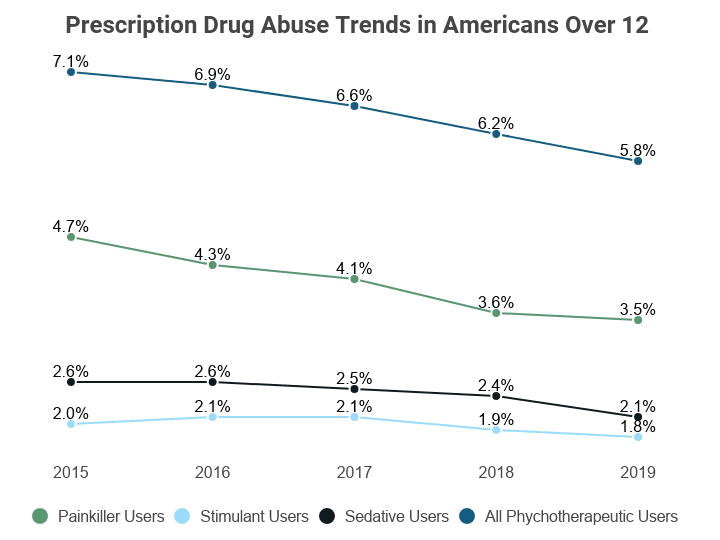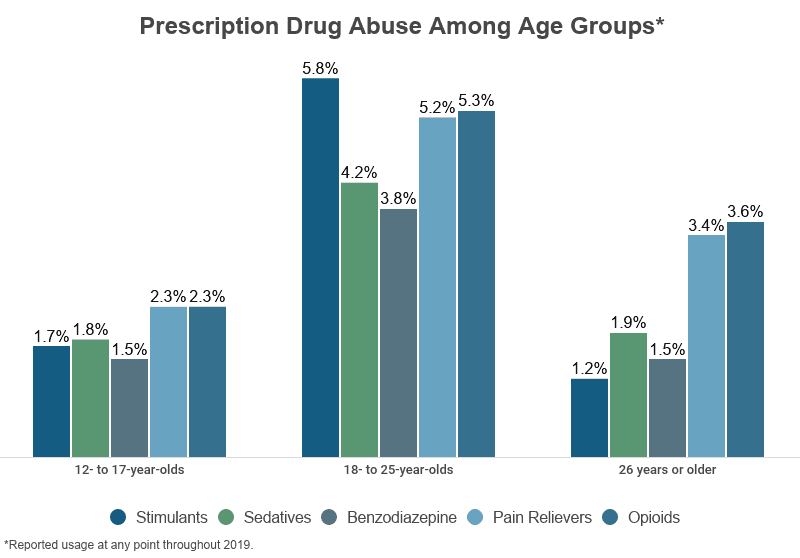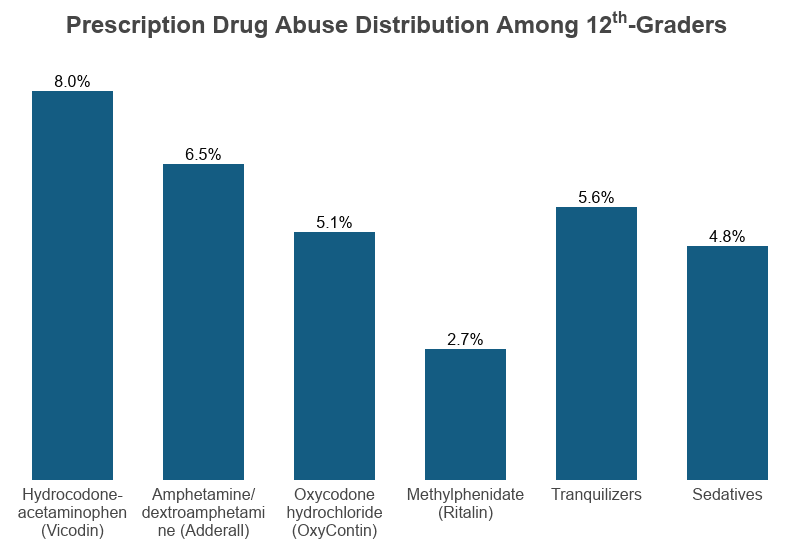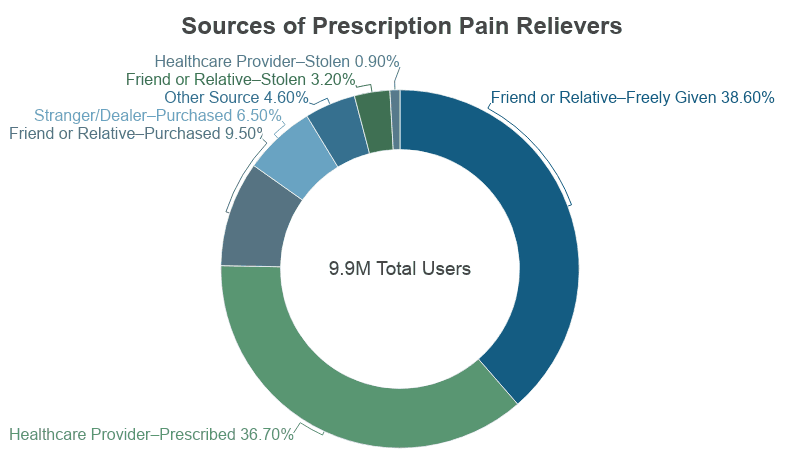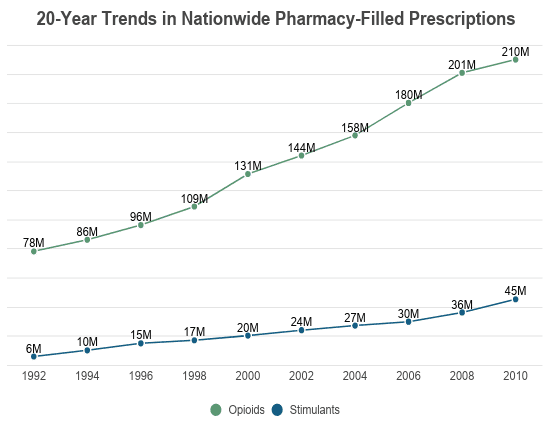Prescription drug abuse is insidious and widely misunderstood. Young adults are the heaviest users, but older and elderly patients are at heightened risk of misuse and addiction.
Key Findings
16M6% of Americans over the age of 12 abuse prescriptions in a year.2M12% of prescription drug abusers are addicted.82%4 out of 5 pharmacy-filled prescriptions are opioids.
Prescription Drug Type Annual Abusers % Among Rx Abusers % Among Americans* Painkillers 9.7 million 59.5% 3.43% Opioids Alone 9.3 million 57.1% 3.29% Sedatives 5.9 million 36.2% 2.08% Stimulants 4.9 million 30.1% 1.73% Benzodiazepine Alone 4.8 million 29.4% 1.70% All Prescription Drugs 16.3 million 100% 5.76% *Aged 12 and older. Note multiple overlaps among prescription types and users.
Prescription Abuse Statistics
45.8% of American adults used a prescription drug – legally or not – within the past 30 days. Healthcare specialists generally agree that a high rate of use and availability drives reported rates of prescription drug abuse, addiction, and ultimately, overdose.
- 16.3 million people misuse prescriptions in a year.
- 22.6% of them or 3.7 million people misuse prescriptions for the first time.
- 43.3% of first time abusers use painkillers while 32.1% use sedatives or tranquilizers.
- 52 million or 18.4% of Americans over the age of 12 have deliberately misused prescription drugs at least once in their lifetime.
- Prescription drug abusers constitute 5.76% of Americans over the age of 12.
- Prescription abuse has declined 13.8% from 2015, when 18.9 million people misused prescriptions.
- Fewer than 1-in-10 prescription abusers misuses drugs with the goal to get high.
- 2.0 million people or 11.9% of people who misuse prescriptions are definitively addicted to the prescription drugs they misuse.
- Among addicts, 253,100 or 12.7% acknowledge their addiction.
- Prescription drugs are the third-most abused illegal substance after marijuana (with 19.4% of the population using) and cocaine (with 15.9% usership).
- Prescriptions are the fifth-most abused substance after alcohol (65.5% usage) and tobacco products (26.7% usage).
Commonly Abused Psychotherapeutic Prescriptions Adderall® With a usage rate of 75.8% among stimulant abusers, Adderall is the most popular stimulant for self-medication. Prescribed as a treatment for attention deficit hyperactivity disorder (ADHD), this cocktail of amphetimines’ primary illicit use is to be ground and snorted as a “study aid”. Ativan® A benzodiazepine, Ativan is the brand name for a tranquilizer (lorazepam) intended to treat acute anxiety. This prescription drug’s biggest appeal is its rapid onset; Ativan users are intoxicated within minutes of ingesting this substance. Morphine A well-known analgesic, morphine is a synthetic narcotic prescribed under many brand names, including Astramorph, Avinza, DepoDur, Duramorph, and Kadian, among others. Oxycodone Oxycodone or “oxy” is the opioid that makes powerful and highly addictive painskillers, such as OxyContin®. The makers of OxyContin have been subject to multiple lawsuits regarding the drug’s role in the national opioid overdose epidemic. Ritalin® Ritalin is a brand name for a stimulant (methylphenidate) used by 24.5% of prescription stimulant abusers. Intended for use as an ADHD treatment, Ritalin is used nonmedically as a study aid or to stay alert. Vicodin® Hydrocodone is paired with acetominophen (Tylenol®) to make this highly addictive painkiller. Hydrocodone is an opioid, the deadliest class of prescription drugs. Xanax® Also referred to as “xans” or “xannies”, Xanax is a brand name for alprazolam, a benzodiazepine. Doctors and psychiatrists prescribe this tranquilizer to treat anxiety and panic disorders. Psychotherapeutic Abuse
The types of prescriptions people abuse most are classified as psychotherapeutic drugs. These are drugs that may be prescribed to aid mental, emotional, and/or physical health.
- Psychotherapeutic drugs are generally categorized as painkillers, stimulants, sedatives, and tranquilizers.
- 59.5% of prescription drug abusers use pain relievers.
- 25.42% of prescription drug users take drugs from multiple categories.
- The most common reason people give for prescription drug abuse is trouble sleeping.
- 75% of prescription abusers receive the drugs from a friend, relative, or healthcare provider.
- 36.7% of abusers misuse their own prescriptions.
- 16% of abused prescriptions are black market purchases.
What is prescription abuse? Taking medicine that was prescribed for someone else. Taking more medicine than you are supposed to in one dose. Taking medicine in a different way than you are supposed to, such as crushing up pills and snorting them. Using medicine for non-medicinal purposes (i.e., getting high). Painkiller Abuse Statistics
Pain relievers or painkillers are drugs designed to diminish or eliminate pain. Opioids fall under this umbrella term, as well as oxycodone, morphine, and fentanyl.
- 9.7 million people over 12 misuse painkillers, 16.5% for the first time, making it the most-abused type of prescription drug.
- 70% of prescription drug addicts are addicted to painkillers.
- 59.3% of prescription drug abusers misuse painkillers; that’s 3.5% of people over 12.
- 65.7% of painkiller abusers report using the drug to relieve physical pain.
- Just 11.3% of painkiller users misuse the drug to feel good or get high; this is a 6.6% annual increase.
- Other reported reasons for use are to relieve tension (10.0%), help with feelings or emotions (3.8%), help with sleep (3.7%), and to experiment or “see what it’s like” (2.2%).
- 1.9% of painkiller users say they are addicted.
- Side effects of painkiller abuse include seizures, a weakened immuse system, an increased risk of heart disease, apnea (stop breathing), coma, and death.
Types of psychotherapeutic painkillers, including prescription opioids Commonly Abused Prescription Painkillers Barbiturates Fentanyl Morphine Buprenorphine Hydrocodone Oxycodone Codeine Hydromorphone Oxymorphone Demerol® Methadone Tramadol Opioid Abuse Statistics
Opioids are the most abused drug type, with addiction and overdose rates climbing annually.
- 9.3 million people abuse prescription opioids specifically, or 95.9% of people who abuse any prescription painkiller.
- 8.6 million or 92.1% of prescription opioid abusers misuse prescription opioids only.
- 404,000 or 4.0% of prescription opioid abusers also use heroin.
- 54.2% of heroin users also use prescription opioids.
- Opioid abuse has declined 21.3% since 2015.
- Opioid prescriptions increased 169% from 1992 to 2010.
- Pharmacies filled 165 million more opioid prescriptions than stimulant prescriptions in 2010.
- One of the greatest dangers of opioid use is accidental ingestion of fentanyl.
Signs and Symptoms of Opioid Abuse:
- Confusion
- Drowsiness
- Poor coordination
- Pinprick pupils
- Euphoria
- Slowed breathing
- Nausea and/or constipation
- Increased tolerance; increased doses needed to relieve pain
- Hyperalgesia; and increased sensitivity to pain
Signs and Symptoms of Opioid Overdose
- Cold, sweaty skin
- Tremors or shaking
- Trouble breathing
- Difficulty speaking
- Unconsciousness
What is Naloxone? Naloxone or Narcan® acts as an antidote to an opioid overdose, reversing the overdose (OD) effects. When applied according to the instructions supplied with the box, this nasal spray medication can save an OD victim’s life. Stimulant Abuse Statistics
Some of the most popular prescription stimulants are ADHD medications, such as Adderall and Ritalin.
- 4.9 million people over 12 misuse prescription stimulants within 12 months, 18.4% for the first time.
- 51.0% of stimulant abusers are aged 26 or older, representing 1.2% of this age group.
- 40.8% of stimulant users are 18 to 25 years old, representing 5.8% of that age group.
- 8.8% of users are 12- to 17-year-olds, representing 1.7% of that age group.
- Stimulant abuse is down 10% since 2015.
- Stimulants include amphetamine, methylphenidate, anorectic (weight-loss) stimulants, and Provigil®, among others.
- 19% of stimulant abusers report using the drug to help with academic studies.
- 50.7% of abusers report using stimulants to stay alert and/or concentrate.
- 9.8% of stimulant abusers report using the drug to get high while 4.1% use with the goal of losing weight.
- Other reported reasons for use include experimentation (5.8%) or to increase/decrease the effects of another drug (1.1%).
- 0.2% of stimulant abusers say they are addicted.
- Long-term effects of stimulant abuse include damage to liver, kidneys, and blood vessels.
- Physical side effects of stimulant abuse also include heart attack, stroke, increased blood pressure, an increased risk of heart disease, arrhythmia (irregular heartbeat), seizures, dehydration, apnea, coma, and death.
Sedative and Tranquilizer Abuse
Sedatives and tranquilizers are similar drug types, promoting sleep and calm respectively. Some drugs are classified as both. Tranquilizers are more likely to be abused for the purpose of getting high.
- 5.9 million people over the age of 12 abuse sedatives and/or tranquilizers, 20.1% for the first time.
- 41.1% of tranquilizer abusers report using the drug to relieve tension.
- 20.9% of users report taking tranquilizers as sleep aids while 15.8% use tranquilizers to cope with emotions.
- 6.7% of tranquilizer users do so experimentally.
- 67.8% of sedative abusers report using the drug as a sleep aid.
- 19.6% of users report taking a sedative to relieve tension.
- Other reported reasons for use are emotional coping (4.2%), intoxication (4.1%), and experimentation (1.8%).
- Just 0.7% of tranquilizer users and 0.3% of sedative users say they are addicted.
- Side effects of sedative and/or tranquilizer abuse include liver failure, depression, amnesia, abnormal blood pressure, seizures, nightmares and night terrors, vision reduction or loss, apnea, coma, and death.
Prescription Sedatives Barbiturates, benzodiazepine, eszopiclone (Lunesta), flurazepam, temazepam, triazolam, zaleplon, and zolpidem (Ambien), among others. Prescription Tranquilizers Alprazolam, benzodiazepine, clonazepam (Klonopin), diazepam (Valium), lorazepam, and muscle relaxers, among others. Prescription Abuse Demographics
People of all ages, races, and socioeconomic backgrounds misuse prescription painkillers.
- Women are 11% more likely than men to be prescribed medication, but men are 22.9% more likely to misuse prescriptions.
- Both men and women are most likely to use pain relievers, with 32.5% more men than women using.
- Women are more likely to use stimulants as study aids or to increase alertness; men are more likely to use stimulants for the purposes of getting high or experimentation.
- College initiates to stimulants are more likely to abuse them as study aids whereas pre-college initiates are more likely to abuse stimulants for fun or out of curiosity.
- Hispanic and Caucasian Americans are most likely to abuse stimulants.
- African Americans are least likely to abuse stimulants, undercutting Asian usage rates by nearly half (47.0%).
- One study found opioid use before high school to be “independently associated with a 33% increase in the risk of future opioid misuse after high school.”
Prescription Abuse by Age
Prescription drug abuse is most common among 18- to 25-year-olds. Some studies indicate that senior and elderly medicated patients may be at heightened risk of developing addiction due to the number and variety of drugs they take for health reasons.
- 14.4% of adults aged 18 to 25 abuse prescription drugs annually.
- More than 80 percent of older patients (ages 57 to 85 years) use at least one prescription medication on a daily basis.
- Among adults aged 40 to 79 years, 69.0% used a prescription within the past 30 days; 22.4% used 5 or more prescriptions.
- Over 50 percent of these older patients take more than five medications or supplements daily.
- Among 12- to 17-year-olds, 4.9% abuse prescriptions annually.
- Hydrocodone-acetaminophen (Vicodin) is the favorite prescription drug among high school seniors with 8% reporting use.
- The stimulant amphetamine/dextroamphetamine (Adderall) are the second favorite, used by 6.5% of 12th-graders.
- 5 of the top 10 reasons teenagers misuse prescription drugs have to do with accessibility.
- 62% of teenagers say they choose to abuse prescription drugs because they’re easy to get from parents’ medicine cabinets.
- 35% say they use prescriptions because they incorrectly believe prescriptions are “safer than illegal drugs”.
Signs of Prescription Abuse
A certain set of characteristics help friends, family, doctors, co-workers, etc. of a potential problem with prescription drug abuse.
- Stealing, forging, or selling prescriptions is an indication someone might be abusing drugs. Some of the stash may be for their personal use while sales income helps fund more prescriptions.
- Taking doses beyond the recommended amount in quantity or frequency is a sign that someone has developed a tolerance to the drug; this is a definitive characteristic of addiction.
- Mood swings, hostility, unusual sleeping habits, and poor decision-making are all signs that someone may be abusing prescription drugs. Sedatives and stimulants both have powerful effects on energy and sleep.
- Doctor shopping or seeing an excessive number of medical professionals may be signs of prescription drug abuse. Addicts usually request early refills or “lose” prescriptions until a doctor grows suspicious and stops writing them.
Prescription Abuse Prevention
It is statistically likely that you or someone you know has abused a prescription drug within the last 12 months.
- Always follow usage instructions. Never use a prescription in a way other than as directed by your doctor.
- Don’t order prescriptions online unless it is with a known reputable pharmacist. Many cases of accidental overdose can be traced to websites advertising as pharmacies that fill prescriptions at a very discounted rate. Many of these drugs are counterfeit and contain deadly doses of a substance unknown to the user.
- Never sell or give away prescription drugs. Sharing prescriptions is dangerous for many reasons, among them enabling drug abuse.
- Always properly dispose of leftover prescriptions. Many pharmacies offer safe destruction and disposal services for prescription drugs.
- Encourage treatment without judgement or shame. By the time they realize they need treatment, most drug addicts have already experienced judgement and shame. Their final hurdle is fear of failure, so focusing on progress and success is crucial. Everyone needs some help to overcome addiction.
Historical Context
Humans have abused substances for thousands of years. Psychotherapeutic drugs were unknown until the 1950s.
- Valium® (diazepam) was one of the earliest psychotherapeutic brands available; it has remained one of the most prescribed medications worldwide since its market launch in 1963.
- Prescription drug abuse generally was not part of national drug abuse and addiction studies until the 21st century, when prescription opioid abuse became an evolving problem.
- From 2002 to 2012, between 2.3 and 2.8 million Americans aged 12 and older abused prescriptions for the first time each year.
- In 2013, 2.0 million tried prescription drugs for the first time.
- In 2015, the International Narcotics Control Board reported that Americans were responsible for 99.7% of the world’s hydrocodone consumption.
- While prescription rates and prescription abuse increased over decades, many psychotherapeutic drug classes, such as stimulants, are diminishing in both use and abuse.
- Initiation levels are higher, however, exceeding 2013’s initiates by 85%.
- In 2017, the U.S. Department of Health and Human Services declared opioid abuse and addiction a national public health emergency.

